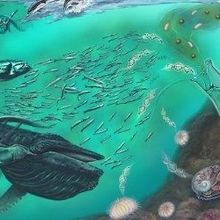Login
Subscribeenvironmental dna

Environmental RNA Reveals Heat Stress in Water Fleas
Katherine Irving | Dec 2, 2022 | 5 min read
The eRNA detection method could one day be used to catch early warning signs of distress in wild ecosystems.

Finding The Cause of Mammoth Extinction
Sejal Davla, PhD | Sep 7, 2022 | 3 min read
Environmental DNA and climate change data suggest that vegetation scarcity led to the mass extinction of herbivore species, including Arctic mammoths.

Scratchy Scalps Help Glue Together Pieces of an Ancient Past
Chloe Tenn | Dec 29, 2021 | 3 min read
Scientists find human DNA preserved in lice cement from the heads of South American mummies.

Our Favorite Genetics Stories of 2021
Christie Wilcox, PhD | Dec 23, 2021 | 4 min read
Studies The Scientist covered this year illustrate the expanding importance of genetic and genomic research in all aspects of life science, from ecology to medicine.

Environmental DNA Can Be Pulled from the Air
Amanda Heidt | Apr 7, 2021 | 4 min read
A proof-of-concept study uses eDNA in the air to detect mammals, expanding the technique beyond aquatic sampling.

Image of the Day: Attendance Record
Carolyn Wilke | Feb 11, 2019 | 1 min read
Genetic material left behind on flowers can reveal which insects have visited.

Researchers Track Sharks and Whales Using DNA in Seawater Samples
Jef Akst | Jan 1, 2019 | 5 min read
In addition to detecting unseen organisms in the ocean, studies of environmental DNA can shed light on the genetic structure of marine populations.

Opinion: How We Found a New Way to Detect “Hidden Sharks”
Judith Bakker and Stefano Mariani | May 7, 2018 | 4 min read
Given the speed and efficiency of environmental (eDNA) sampling, a much larger portion of the sea can be screened, in a shorter time, for patterns of diversity.

Recreating Fish Migration Written Through Environmental Genomics
Aggie Mika | Jul 16, 2017 | 5 min read
Scientists examine floating traces of DNA left by fish to better understand New York’s aquatic life.

No Place to Hide
Claire Asher | May 31, 2017 | 7 min read
Environmental DNA is tracking down difficult-to-detect species, from rock snot in the U.S. to cave salamanders in Croatia.
